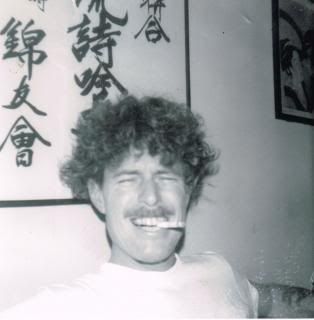Author:
Karnamrita Das
Someone asked me to share my Vyasa-puja (as the appearance day of one’s guru is called in Gaudiya Vaishnava tradition) offering….
Websites from the ISKCON Universe
Author:
Karnamrita Das
Someone asked me to share my Vyasa-puja (as the appearance day of one’s guru is called in Gaudiya Vaishnava tradition) offering….
Author:
Karnamrita Das
(this blog is recorded on the full page: quick time player needed; work…
(this blog is recorded on the full page: quick time player needed; works best with Firefox or Explorer)
Reflecting on my life and the lives of those I know and read about, I see how much we all struggle with our material natures and tendencies, and how these can negatively impact our relationships with others. Even though we suffer on account of identifying with our bodies and minds, we remain attached to our limited perspectives or biased lenses, finding it difficult to accept that our entire problem of life is physicality. Ignorance is bliss runs the material world, and since we have invested so much time and energy in trying to enjoy worldly happiness, we don’t want to admit our folly in its pursuit. This is why spiritual knowledge is so essential, and even more so, realization of these truths.
Stated another way, many people may casually understand that they “have” a soul, but few try to act as one, or make realizing their soul and its relationship with God their life’s true quest. Genuine spiritual paths are meant to give us tools to realize our spiritual nature. In Gaudiya Vaishnavism, chanting the holy name and engaging in pure devotion (shuddha bhakti) are the means to uncover our soul and let it shine in love of Krishna. Material consciousness is muddy consciousness, while soul consciousness is like pure mountain water. This is why we speak often of “purification” when speaking about the effect of spiritual practices. Purification means taking away the mud of matter from our consciousness, so our real nature as willing instruments for divine purpose will gradually manifest.
The basics of bhakti are frequently repeated since the fundamentals need to be mastered before higher stages are obtained. While devotees of Krishna accept the fact that the ABC’s of spiritual life involve realizing that “we are not the body,” this isn’t so easy, even after many years of practice.
(this blog is recorded on the full page: quick time player needed; works best with Firefox or Explorer)
Reflecting on my life and the lives of those I know and read about, I see how much we all struggle with our material natures and tendencies, and how these can negatively impact our relationships with others. Even though we suffer on account of identifying with our bodies and minds, we remain attached to our limited perspectives or biased lenses, finding it difficult to accept that our entire problem of life is physicality. Ignorance is bliss runs the material world, and since we have invested so much time and energy in trying to enjoy worldly happiness, we don’t want to admit our folly in its pursuit. This is why spiritual knowledge is so essential, and even more so, realization of these truths.
Stated another way, many people may casually understand that they “have” a soul, but few try to act as one, or make realizing their soul and its relationship with God their life’s true quest. Genuine spiritual paths are meant to give us tools to realize our spiritual nature. In Gaudiya Vaishnavism, chanting the holy name and engaging in pure devotion (shuddha bhakti) are the means to uncover our soul and let it shine in love of Krishna. Material consciousness is muddy consciousness, while soul consciousness is like pure mountain water. This is why we speak often of “purification” when speaking about the effect of spiritual practices. Purification means taking away the mud of matter from our consciousness, so our real nature as willing instruments for divine purpose will gradually manifest.
The basics of bhakti are frequently repeated since the fundamentals need to be mastered before higher stages are obtained. While devotees of Krishna accept the fact that the ABC’s of spiritual life involve realizing that “we are not the body,” this isn’t so easy, even after many years of practice.
Karnamrita Das
(this blog is recorded on the full page: quick time player needed; works best with Firefox or Explorer)
Although Krishna reveals in his Bhagavad Gita that the purpose of the Vedic wisdom is to know, remember, serve, and love him, this truth is also the most confidential knowledge, since readers of these texts are often attracted by lessor recommendations, like the attainment of heaven, or merging into his effulgence (Brahman). What qualification is needed to uncover this truth from the jungle of sounds of the Vedas, and take up this most confidential, though obscured, path of bhakti, the greatest and most valuable treasure? One would think that such a rare gem would only be available to the most qualified persons. However, by the mercy of Shri Chaitanya Mahaprabhu, this treasure is readily available, initially requiring only one’s faith in the process. I use myself as an example to demonstrate this, not to say I’m great, but to highlight that I had no apparent qualification, and only have standing in bhakti by mercy alone. Thus there is hope for everyone.
The first time I spoke with devotees of Krishna I was very attracted to their peaceful, otherworldly, and joyful demeanor, and it was only a short time till I moved into a temple community to become a full time member. That might seem like a whimsical, spontaneous decision, but actually a lot of background took place which enabled me to do this. During the previous year, my life took a dramatic shift. I began an all-out quest to find the meaning of life, and my place in the world, concluding that I needed to become a monk in some tradition in order to immerse myself in spiritual practice.
How could this have happened to someone like me, who by all appearances was a very ordinary, not even religious, or observably pious, person—fallen even by Western standards?
Karnamrita Das
(this blog is recorded on the full page: quick time player needed; works best with Firefox or Explorer)
Although Krishna reveals in his Bhagavad Gita that the purpose of the Vedic wisdom is to know, remember, serve, and love him, this truth is also the most confidential knowledge, since readers of these texts are often attracted by lessor recommendations, like the attainment of heaven, or merging into his effulgence (Brahman). What qualification is needed to uncover this truth from the jungle of sounds of the Vedas, and take up this most confidential, though obscured, path of bhakti, the greatest and most valuable treasure? One would think that such a rare gem would only be available to the most qualified persons. However, by the mercy of Shri Chaitanya Mahaprabhu, this treasure is readily available, initially requiring only one’s faith in the process. I use myself as an example to demonstrate this, not to say I’m great, but to highlight that I had no apparent qualification, and only have standing in bhakti by mercy alone. Thus there is hope for everyone.
The first time I spoke with devotees of Krishna I was very attracted to their peaceful, otherworldly, and joyful demeanor, and it was only a short time till I moved into a temple community to become a full time member. That might seem like a whimsical, spontaneous decision, but actually a lot of background took place which enabled me to do this. During the previous year, my life took a dramatic shift. I began an all-out quest to find the meaning of life, and my place in the world, concluding that I needed to become a monk in some tradition in order to immerse myself in spiritual practice.
How could this have happened to someone like me, who by all appearances was a very ordinary, not even religious, or observably pious, person—fallen even by Western standards?
Karnamrita Das
(this blog is recorded on the full page: quick time player needed; works best with Firefox or Explorer)
Two of the top difficult things to understand—out of many—for new readers of Bhagavad gita are the personhood of Krishna, and his Universal Form. Of course they are related, since Krishna reveals that the Universal Form comes from him, and is a manifestation of his energy as the material world. In particular this display of the Universal Form (there are others), though inspiring to show the greatness and inconceivableness of God, is also at times ghastly and fearsome, and as a form of time, “the destroyer of the worlds,” all of which may be disconcerting. While Krishna is both the creation and annihilation of everything he is also the seed of all existence, the life of all that lives, and the soul of our souls, so we have to look at the whole picture before being able to evaluate who Krishna is.
Krishna could have demonstrated his nature as the creator and maintainer by showing baby animals, lovely human children, beautiful scenes in Nature, the universe being incredibly sustained and flourishing, but specifically to get Arjuna’s attention, he wanted to encourage Arjuna in his duty of fighting by showing him that the great warriors he had to fight were already killed by Krishna’s power–in fact we all must die, our bodies that is, at our allotted time. For conditioned living beings, the Universal Form teaches us that the material world is temporary, and not really suitable for eternal souls to live, since bodies, planets, and the entire Universe are constantly changing, and will ultimately be vanquished. The point is that Krishna is present in all things and, through his energy, is everything. His greatness is all-sided and unlimited, manifested in the subatomic dimension and as the whole universe—in the micro and macro-cosmic level. For us imperfect and limited souls, he can be experienced in what we can observe. Though we can’t perceive his spiritual form, or even our own souls, we can, by the grace of the Bhagavad Gita, Shrimad Bhagavatam, and the mercy of the devotees who live by such revealed Vedic literature, “see” him, specifically in “…all opulent, beautiful and glorious creations…”[ Bg 10.41].
In what follows I will share some highlights of these manifestations of Krishna from the Bhagavad Gita, which is another version of the Universal Form, or Krishna’s material form.
Karnamrita Das
(this blog is recorded on the full page: quick time player needed; works best with Firefox or Explorer) [Originally published on July 1, 2013, though the topic is timeless, the endeavor constant]Two of the top difficult things to understand—out of many—for new readers of Bhagavad gita are the personhood of Krishna, and his Universal Form. Of course they are related, since Krishna reveals that the Universal Form comes from him, and is a manifestation of his energy as the material world. In particular this display of the Universal Form (there are others), though inspiring to show the greatness and inconceivableness of God, is also at times ghastly and fearsome, and as a form of time, “the destroyer of the worlds,” all of which may be disconcerting. While Krishna is both the creation and annihilation of everything he is also the seed of all existence, the life of all that lives, and the soul of our souls, so we have to look at the whole picture before being able to evaluate who Krishna is.
[Originally published on July 1, 2013, though the topic is timeless, the endeavor constant]Two of the top difficult things to understand—out of many—for new readers of Bhagavad gita are the personhood of Krishna, and his Universal Form. Of course they are related, since Krishna reveals that the Universal Form comes from him, and is a manifestation of his energy as the material world. In particular this display of the Universal Form (there are others), though inspiring to show the greatness and inconceivableness of God, is also at times ghastly and fearsome, and as a form of time, “the destroyer of the worlds,” all of which may be disconcerting. While Krishna is both the creation and annihilation of everything he is also the seed of all existence, the life of all that lives, and the soul of our souls, so we have to look at the whole picture before being able to evaluate who Krishna is.
Krishna could have demonstrated his nature as the creator and maintainer by showing baby animals, lovely human children, beautiful scenes in Nature, the universe being incredibly sustained and flourishing, but specifically to get Arjuna’s attention, he wanted to encourage Arjuna in his duty of fighting by showing him that the great warriors he had to fight were already killed by Krishna’s power–in fact we all must die, our bodies that is, at our allotted time. For conditioned living beings, the Universal Form teaches us that the material world is temporary, and not really suitable for eternal souls to live, since bodies, planets, and the entire Universe are constantly changing, and will ultimately be vanquished. The point is that Krishna is present in all things and, through his energy, is everything. His greatness is all-sided and unlimited, manifested in the subatomic dimension and as the whole universe—in the micro and macro-cosmic level. For us imperfect and limited souls, he can be experienced in what we can observe. Though we can’t perceive his spiritual form, or even our own souls, we can, by the grace of the Bhagavad Gita, Shrimad Bhagavatam, and the mercy of the devotees who live by such revealed Vedic literature, “see” him, specifically in “…all opulent, beautiful and glorious creations…”[ Bg 10.41].
In what follows I will share some highlights of these manifestations of Krishna from the Bhagavad Gita, which is another version of the Universal Form, or Krishna’s material form.
Karnamrita Das
(this blog is recorded on the full page: quick time player needed; works best with Firefox or Explorer)
[reposted from 6-25-13] Two days after my birthday was my fathers’, or June 24th. This year I wanted to share some snapshots in my relationship with him, in the hope that it might be useful to you in your journey of self-exploration, making peace with your past (if required), or in general, having a balanced psychology so favorable for spiritual practice. Dear reader, I am indebted to you for taking the time to read this, and to think about your own relationship with your parents. What does it tell you about the nature of the material world of (re)birth, disease, old age, death and disappointment, and the importance of receiving the saving grace of spiritual knowledge and bhakti practices to uncover the eternal life of the soul?
I was running a preaching center on O Street in Washington D.C. in 1986. After leaving Baltimore with Maha-nidhi Swami to travel and preach, I gradually felt it would be a natural move to stay there. I had a small staff which fluctuated between 1 or 2 devotees. I also received some morale boosting, and financial support from the near-by Potomac MD, Temple from which devotees sometimes visited to chant, preach, or help cook. We held three feasts a week, mainly attended by college students and young people in the area. All was going fine for a few months after I settled in, and then, one afternoon between feasts, I felt like something ominous was in the air. It was a typical August sunny, muggy day, nothing unusual but this feeling. Although I couldn’t put my finger on the possible reason, I prayed for clarity to understand. As I was lost in thought, the ringing of the phone startled me. It was Barbara, my father’s current wife. She told me that my father had committed suicide by shooting himself in the head.
A long silence ensued. I didn’t have a personal reaction, being in shock, and besides, I wasn’t very good at dealing with others in such matters of intense sorrow. I was at a loss for words, thinking more about her, than for myself. Even today, it seems so inappropriate and trite to say things like “sorry for your loss,” or any number of socially correct statements. Finally, I was able to thank her for letting me know, and told her how sorry I was. Our conversation was awkward,
Karnamrita Das
(this blog is recorded on the full page: quick time player needed; works best with Firefox or Explorer)
Two days after my birthday was my fathers’, or June 24th. This year I wanted to share some snapshots in my relationship with him, in the hope that it might be useful to you in our journey of self-exploration, using that as a balanced platform for spiritual practice. Dear reader, I am indebted to you for taking the time to read this, and to think about your own relationship with your parents. What does it tell you about the nature of the material world of (re)birth, disease, old age, death and disappointment, and the importance of receiving the saving grace of spiritual knowledge and bhakti practices to uncover the eternal life of the soul?
I was running a preaching center on O Street in Washington D.C. in 1986. After leaving Baltimore with Maha-nidhi Swami to travel and preach, after some time I felt it would be a natural move to stay there. I had a small staff which fluctuated between 1 or 2 devotees. I also received some morale boosting, and financial support from the near-by Potomac MD, Temple from which devotees sometimes visited to chant, preach, or help cook. We held three feasts a week, mainly attended by college students and young people in the area. All was going fine for a few months after I settled in, and then, one afternoon between feasts, I felt like something ominous was in the air. It was a typical August sunny, muggy day, nothing unusual but this feeling. Although I couldn’t put my finger on the possible reason, I prayed for clarity to understand. As I was lost in thought, the ringing of the phone startled me. It was Barbara, my father’s current wife. She told me that my father had committed suicide by shooting himself in the head.
A long silence ensued. I didn’t have a personal reaction, being in shock, and besides, I wasn’t very good at dealing with others in such matters of intense sorrow. I was at a loss for words, thinking more about her, than for myself. Even today, it seems so inappropriate and trite to say things like “sorry for your loss,” or any number of socially correct statements. Finally, I was able to thank her for letting me know, and told her how sorry I was. Our conversation was awkward,
(this blog is recorded on the full page: quick time player needed; works best with Firefox or Explorer)
Are you ready to be free (?)
it doesn’t mean being a tree—
you laugh, but our body is the same—
we’re forced to choose survival,
for the tree, growing to the light
thinking that this is life’s purpose,
and we’re forced to be human
identifying with race, gender, age
mental likes and dislikes—physicality.
If we could only realize our self
the simple truth of spiritual existence
not defending what can’t endure:
our conception of material identity
(this blog is recorded on the full page: quick time player needed; works best with Firefox or Explorer)
Are you ready to be free (?)
it doesn’t mean being a tree—
you laugh, but our body is the same—
we’re forced to choose survival,
for the tree, growing to the light
thinking that this is life’s purpose,
and we’re forced to be human
identifying with race, gender, age
mental likes and dislikes—physicality.
If we could only realize our self
the simple truth of spiritual existence
not defending what can’t endure:
our conception of material identity
Karnamrita Das
(this blog is recorded on the full page: quick time player needed; works best with Firefox or Explorer)
While we often hear Shrila Prabhupada’s statement that “our relationships should be based on love and trust,” we don’t often expand on how this can be created and maintained. One process I have found helpful is something we teach in our relationship seminars, namely the practice of checking the balance in the “Emotional Bank Account” that we have with another person—do we have a surplus of positive emotions, or are we overdrawn, in the red?
This is a metaphor that Stephen Covey [The Seven Habits of Highly Effective People] first came up with to describe “the amount of trust that’s been built up in a relationship.” This statement really piqued my curiosity and interest in his work, and after scrutiny, dovetails nicely as a support to putting into practice Prabhupada’s aphorism. Just as we have bank accounts to keep our money in, we also have “bank accounts” to store our “emotional capital” or the energy that sustains or strains (if it becomes depleted) relationships.
We could also consider this capital like a trust meter, and trust is the basis of reciprocal loving dealings. Very few people love unconditionally, but most of us require more positive interactions (deposits), than negative ones (withdrawals), to stay, or be happy, in a relationship.
Karnamrita Das
(this blog is recorded on the full page: quick time player needed; works best with Firefox or Explorer)
While we often hear Shrila Prabhupada’s statement that “our relationships should be based on love and trust,” we don’t often expand on how this can be created and maintained. One process I have found helpful is something we teach in our relationship seminars, namely the practice of checking the balance in the “Emotional Bank Account” that we have with another person—do we have a surplus of positive emotions, or are we overdrawn, in the red?
This is a metaphor that Stephen Covey [The Seven Habits of Highly Effective People] first came up with to describe “the amount of trust that’s been built up in a relationship.” This statement really piqued my curiosity and interest in his work, and after scrutiny, dovetails nicely as a support to putting into practice Prabhupada’s aphorism. Just as we have bank accounts to keep our money in, we also have “bank accounts” to store our “emotional capital” or the energy that sustains or strains (if it becomes depleted) relationships.
We could also consider this capital like a trust meter, and trust is the basis of reciprocal loving dealings. Very few people love unconditionally, but most of us require more positive interactions (deposits), than negative ones (withdrawals), to stay, or be happy, in a relationship.
Karnamrita Das
(this blog is recorded on the full page: quick time player needed; works best with Firefox or Explorer)
My wife and I are traveling to the devotee farm community, Gita Nagari, near Port Royal, PA this Thursday to assist other members of the Grihastha Vision Team facilitate a couples’ retreat this weekend (June 7-9). In preparing for our part of the retreat, I’m naturally thinking of what makes a successful marriage and relationship. What might be some helpful tips, like sutras or codes, seeds to plant, that will ideally give rise to reflections on how to grow, nurture, and implement them? In many people’s experience, solutions to life’s varied problems are often simple to explain, but more difficult to carry out. However, where there is a will, there is a way, combined with prayer and a good support system.
Before I explain them in a little detail, let’s cut to the chase, by listing all four tips:
Tip 1: Be committed to personal growth work and the introspection it fosters in order to become the best person you can. Work on letting go of those parts of your conditioning that are unfavorable for having happy, healthy, and meaningful relationships. In short, “Know thyself,” or your strengths and weaknesses, and strive to improve for everyone’s benefit.
Karnamrita Das
(this blog is recorded on the full page: quick time player needed; works best with Firefox or Explorer)
My wife and I are traveling to the devotee farm community, Gita Nagari, near Port Royal, PA this Thursday to assist other members of the Grihastha Vision Team facilitate a couples’ retreat this weekend (June 7-9). In preparing for our part of the retreat, I’m naturally thinking of what makes a successful marriage and relationship. What might be some helpful tips, like sutras or codes, seeds to plant, that will ideally give rise to reflections on how to grow, nurture, and implement them? In many people’s experience, solutions to life’s varied problems are often simple to explain, but more difficult to carry out. However, where there is a will, there is a way, combined with prayer and a good support system.
Before I explain them in a little detail, let’s cut to the chase, by listing all four tips:
Tip 1: Be committed to personal growth work and the introspection it fosters in order to become the best person you can. Work on letting go of those parts of your conditioning that are unfavorable for having happy, healthy, and meaningful relationships. In short, “Know thyself,” or your strengths and weaknesses, and strive to improve for everyone’s benefit.
Karnamrita Das
(this blog is recorded on the full page: quick time player needed; works best with Firefox or Explorer)
Shri Nrisimhadeva’s appearance is one of my favorite holy days. His lila is so illuminating and important. Though I wanted to prepare this offering by the actual day, it wasn’t meant to be–occurrences and other duties diverted me–and yet, that is also part of the teaching: to see everything in relationship to God and to keep a humble service mood throughout. Whether pulling weeds and planting, or having one’s car battery die–everything is instructive. In this case, reminding me to keep my devotional creeper free of “weeds”, and that I must recharge my batteries with spiritual practice. May the fire of spiritual life burn brightly in our hearts and souls!
Unusual life events
intersect with special days
strange creatures prepare us
emerging from the ground
shedding their skins to fly
teaching us to transform
if we want to dwell in the sky
realizing our true self
keeping our purpose in mind
always vibrating the primal sound
the great chant for deliverance
17 year cicada’s ballad serenades
Lord Nrisimhadeva’s appearance.
Eerie sounds like alien starships
reminding us of the extraordinary
half man, half lion incarnation
Karnamrita Das
(this blog is recorded on the full page: quick time player needed; works best with Firefox or Explorer)
Shri Nrisimhadeva’s appearance is one of my favorite holy days. His lila is so illuminating and important. Though I wanted to prepare this offering by the actual day, it wasn’t meant to be–occurrences and other duties diverted me–and yet, that is also part of the teaching: to see everything in relationship to God and to keep a humble service mood throughout. Whether pulling weeds and planting, or having one’s car battery die–everything is instructive. In this case, reminding me to keep my devotional creeper free of “weeds”, and that I must recharge my batteries with spiritual practice. May the fire of spiritual life burn brightly in our hearts and souls!
Unusual life events
intersect with special days
strange creatures prepare us
emerging from the ground
shedding their skins to fly
teaching us to transform
if we want to dwell in the sky
realizing our true self
keeping our purpose in mind
always vibrating the primal sound
the great chant for deliverance
17 year cicada’s ballad serenades
Lord Nrisimhadeva’s appearance.
Eerie sounds like alien starships
reminding us of the extraordinary
half man, half lion incarnation
Karnamrita Das
(this blog is recorded on the full page: quick time player needed; works best with Firefox or Explorer)
Monday, May 20th is the death anniversary of my mom. I usually post the blog I wrote a few days after she “left her body” (as devotees call death of the physical body, since the soul moves on) three years ago. Although, I’ll give some links for a whole series of blogs I wrote around that time, I would like to express some thoughts for your consideration, and perhaps, for thinking of your own mom, or your relationship to your parents in general. One of the questions I am thinking about is: “How has your relationship with your parents affected your life in terms of your relationships with your spouse and children (if you are married), or to friends, people in general, or yourself?”
There are many events in life which are like initiations into stages of growth, the first being birth and the last death—the number and type of “initiations” in between those two periods are as individual as people are. For me, some of my significant growth opportunities were: moving from Los Angeles to San Francisco at four years old, the shock of going to Junior High School from a tightknit grammar school, when my parents divorced and I had to live with my father, when my High School met Haight-Ashbury (so to speak), or how I let hippiedom appear to torpedo my education but also lay the ground work for my spiritual quest, my second girlfriend, spiritual initiation at 20, my guru Shrila Prabhupada’s leaving his body, marriage, the struggle to find an occupation, and to the point of this blog, the “death” of my parents.
I haven’t spoken about my father’s death, though I should, as he died by his own hand with a 38 Special revolver. He was obviously miserable, felt his life unmanageable, and had no spiritual knowledge to help him. Although I later went to the place where he committed suicide in an attempt to release his soul, in case he had a ghost body, his death was not as fortunate as my moms. I was able to surround her with prayers and a spiritual environment as she passed on.
Karnamrita Das
(this blog is recorded on the full page: quick time player needed; works best with Firefox or Explorer)
[reposted from 05-20-2013]
Saturday, May 20th was the death anniversary of my mom. I usually post the blog I wrote a few days after she “left her body” (as devotees call death of the physical body, since the soul moves on) seven years ago. Although, I’ll give some links for a whole series of blogs I wrote around that time, I would like to express some thoughts for your consideration, and perhaps, for thinking of your own mom, or your relationship to your parents in general. One of the questions I am thinking about is: “How has your relationship with your parents affected your life in terms of your relationships with your spouse and children (if you are married), or to friends, people in general, or yourself?”
There are many events in life which are like initiations into stages of growth, the first being birth and the last death—the number and type of “initiations” in between those two periods are as individual as people are. For me, some of my significant growth opportunities were: moving from Los Angeles to San Francisco at four years old, the shock of going to Junior High School from a tightknit grammar school, when my parents divorced and I had to live with my father, when my High School met Haight-Ashbury (so to speak), or how I let hippiedom appear to torpedo my education but also lay the ground work for my spiritual quest, my second girlfriend, spiritual initiation at 20, my guru Shrila Prabhupada’s leaving his body, marriage, the struggle to find an occupation, and to the point of this blog, the “death” of my parents.
I haven’t spoken about my father’s death, though I should, as he died by his own hand with a 38 Special revolver. He was obviously miserable, felt his life unmanageable, and had no spiritual knowledge to help him. Although I later went to the place where he committed suicide in an attempt to release his soul, in case he had a ghost body, his death was not as fortunate as my moms. I was able to surround her with prayers and a spiritual environment as she passed on.
Karnamrita Das
(this blog is recorded on the full page: quick time player needed; works best with Firefox or Explorer)
[Originally published on 05-16-2013, I’m reposting it now, as I want to share the book with new readers who like my blogs. It is still available in many places in the world.] This was originally the introduction for Give to Live, but we decided to cut it, since the size of the front matter and whole book, had to be reduced. Still, I think it gives a good introduction for the book for those of you who don’t have a copy. Additionally, there is a 15 minute video at the end giving a glimpse into the journey of creating the book.
As an introduction to my book, Give to Live, I am thinking about the blessing (or curse) of being a writer. Part of being a writer is the desire to share experience, which is equally true of photographers, artists and the like—people who try to share their perceptions, feelings and thoughts with others through some different medium of one or more dimensions. Yet, sometimes thinking of an experience (or extracting the creative angle) as it is happening makes one less present in the moment. I have taken photos and videos at some temple functions, and felt like I missed the whole thing!
My usual means of sharing experience is what you are reading—words. I think I am very balanced in my “observer’s eye” in that I really have to work at turning it on. It doesn’t come that naturally for me like with some writers. A friend sent me a book about a poet/gardener now in his 90’s who has always loved words, and writing about nature and his garden. His mood of observation and being in the moment is very impressive to me, as I was such a dull, unobservant, and uncreative child. In my current “later years” I am much more present than I could have ever dreamed as a child, though still very inferior to this poet! It is always good to take the humble position regarding our Krishna-given abilities. We are always dependent on His mercy and help in any endeavor and yet we will always find people much better than we are in anything we do. Never the less, that doesn’t mean we shouldn’t try to use our talents and desires in the service of the Lord, his devotees, and people in general.
Karnamrita Das
(this blog is recorded on the full page: quick time player needed; works best with Firefox or Explorer)
This was originally the introduction for Give to Live, but we decided to cut it, since the size of the front matter and whole book, had to be reduced. Still, I think it gives a good introduction for the book for those of you who don’t have a copy. Adding further to the mystery of this piece of writing is that somehow it disappeared after being posted last week. So I am reposting it again. Do keep an eye on it for me. Additionally, there is a 15 video at the end giving a glimpse into the journey of creating the book.
As an introduction to my book, Give to Live, I am thinking about the blessing (or curse) of being a writer. Part of being a writer is the desire to share experience, which is equally true of photographers, artists and the like—people who try to share their perceptions, feelings and thoughts with others through some different medium of one or more dimensions. Yet, sometimes thinking of an experience (or extracting the creative angle) as it is happening makes one less present in the moment. I have taken photos and videos at some temple functions, and felt like I missed the whole thing!
My usual means of sharing experience is what you are reading—words. I think I am very balanced in my “observer’s eye” in that I really have to work at turning it on. It doesn’t come that naturally for me like with some writers. A friend sent me a book about a poet/gardener now in his 90’s who has always loved words, and writing about nature and his garden. His mood of observation and being in the moment is very impressive to me, as I was such a dull, unobservant, and uncreative child. In my current “later years” I am much more present than I could have ever dreamed as a child, though still very inferior to this poet! It is always good to take the humble position regarding our Krishna-given abilities. We are always dependent on His mercy and help in any endeavor and yet we will always find people much better than we are in anything we do. Never the less, that doesn’t mean we shouldn’t try to use our talents and desires in the service of the Lord, his devotees, and people in general.
Karnamrita Das
(this blog is recorded on the full page: quick time player needed; works best with Firefox or Explorer)
Restrictions, limitations, impositions
though my heart doesn’t like them
the rules of the body and mind
embodied by suffering souls
with difficult pasts and issues
my own and others combined
bring me pain and regret
that they can’t deal with me.